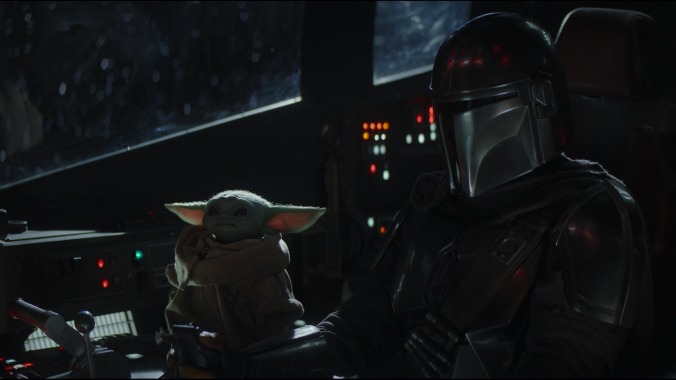The Mandalorian gets even more Western in a standalone adventure


It’s pretty impressive, how vigorously The Mandalorian is celebrating and incorporating classic Western tropes with each new episode, leaving no doubt whatsoever as to what creator Jon Favreau is trying to do here. Episode four, “Sanctuary,” utilizes a narrative so iconic that I couldn’t find just one classic example to represent it: Kurosawa’s Seven Samurai (which led to the American Western classic The Magnificent Seven) is perhaps the closest, though one could also mention the Clint Eastwood classic High Plains Drifter, and the prominent presence of a beautiful widow also invokes Once Upon a Time in the West. But the threads of this story are all pretty familiar: an unlikely hero gets asked to protect a town of innocents from an overwhelming threat.
Of course, in these stories, the unlikely hero starts off reluctant to help, and in this case, The Mandalorian has a very good reason for wanting to stay out of the problems affecting a small village of krill farmers on Sorgan. Having picked this planet because he’s looking for a quiet place (or, in his words, “a back water skud hole”) where no one might track down him and Baby Yoda, all he wants is to lie low for a few months.
Upon his arrival, though, he encounters Cara Dune (the much-anticipated first appearance of Gina Carano), a former “shock trooper” who worked for the Rebellion until after the fall of the Empire. For unspecified but clearly justified reasons, she’s also hiding out on Sorgan — and as she informs Mando following a well-matched scuffle (ending, John Woo-style, with them both pointing blasters at each other), she was there first.
So, the Mandalorian and Baby Yoda (who just loves tagging along with his new surrogate daddy, and god it’s cute to watch him scurry to keep up) prepare to pack up and find another planet, until two krill farmers track him down in the woods. At the beginning of the episode, their village was raided by Klatoonian raiders, and they’re hoping that he’ll be able to chase off the raiders and protect them. (How they know about the Mandalorian and where to find them is a detail that seems to get left on the cutting room floor; presumably, they heard something about him being spotted at the local common house, but it’s not necessarily an important detail.)
Mando isn’t interested in helping them, until they mention just how remote their village is — still in need of a place to hide out, he agrees to help, and even convinces Cara to team up. She’s skeptical this will be worth their time (especially since the farmers are basically paying them “lunch money”), but her tune changes dramatically once they figure out that the raiders have a AT-ST at their disposal. Taking on one of these deadly Empire transport/weapons turns an easy protection gig into what Cara immediately sees as a lost cause, but when she and Mando try to convince the farmers that they need to give up and leave, the farmers refuse. After all, this is their home.
So instead Cara and the Mandalorian put the farmers through some basic combat training, preparing for battle with blasters and pointed sticks. Meanwhile, the Mandalorian has gotten attached to Omera (Julia Jones), a widow whose daughter loves Baby Yoda (which, understandable) and who seems to understand a bit about the customs which keep his face hidden.
For those who have not made an intense study of the Mandalorian Wookiepedia entry (or even casually googled the question “how do Mandalorians eat?”), we learn this week that Mandalorians do take their helmets off for basic necessities, but never in front of other people. Our hero here, who we know was taken in by the tribe after the death of his parents, says that he hasn’t shown his face to another person since he was a child, because he remains loyal to “the way.” He also explains to Cara later that he could take the helmet off, if he wanted to — he could just never put it back on again.
Omera stands out as the only farmer with real skill at shooting, but the other farmers work hard to prepare for battle. (Gotta love a training montage.) The battle that ensues is relatively simple — the raiders, lured out to the krill ponds, are met with an ambush, and thanks to the bravery of Cara, the AT-ST is successfully lured into the trap they’ve set, and Mando runs up to toss a grenade into the control cabin. But episode director Bryce Dallas Howard makes sure that every beat is clean and precise, with an emotionally satisfying conclusion.
The remaining raiders run away, the day is saved, and a few weeks later, Cara, the Mandalorian and Baby Yoda seem to have found a level of comfort among the farmers—Baby Yoda especially seems to love playing with the other children there. It could be a good life for them, especially because, as Cara notes, all it would take for Mando to “settle down with that beautiful young widow” is taking off the helmet. But it’s something he can’t bring himself to do, at least in part because he knows that their battle with the raiders will have attracted some attention, and it isn’t safe for him to stay.
It’s a real credit to Pedro Pascal’s performance, which by necessity relies so heavily just on his voice, that his genuine consideration about settling down with the farmers comes through; the audible catch in his throat when he says “it would” be nice to have some peace only makes the next beat of the scene, in which he tells Omera that it’s not possible for him, that much more affecting.
The Mandalorian does plan to leave Baby Yoda behind with Omera, as life on the run is no place for a baby, 50 years old and Force-powered or otherwise. But when a lone tracker does eventually find them, it’s not Mando or Cara that’s in the crosshairs—it’s the child. Thus, the Mandalorian knows that to protect the village, as well as his new charge, they have to remain together, and so it’s off to the next adventure. “Sanctuary” may be the closest this show has come yet to a standalone episode, but it’s really fun to witness how these sorts of stories can enhance our understanding of who the man is, beneath the mask.
Stray observations
- Watching all of the village kids flip out over Baby Yoda isn’t quite as gratifying as the stories of Werner Herzog’s love for the adorable puppet. But it is FUN.
- Speaking of fun: Cara Dune fits perfectly within this show’s fascinating blend of genres, and fingers crossed she comes back soon. I’ll also say the same is true of Omera (especially because her competence with a blaster indicates a deeper past than your typical farmer), but feel like that’s less likely to happen.
- Some fun casting notes: If villagers Caben and Stoke looked familiar, it’s because they were played by comedians Asif Ali and Eugene Cordero. Among Ali’s many past roles was one of the marooned castaways of TBS’s criminally underrated Wrecked, while Cordero (also a Wrecked alumnus) is probably most recognizable as Jason’s best friend Pillboi on The Good Place.
- Also, the “common house proprietor” (as listed in the credits) who loves big spenders was played by Ida Darvish, who has a number of credits but is also Josh Gad’s wife!
- The episode’s adherence to referring to the Klatoonians’ big metal friend as an “A-T-S-T” invoked memories of the many fights I have had with friends over whether their metal cousins should be called “A-T-A-Ts” or “At-Ats.” Seriously, full-on screaming matches. Lives have nearly lost over this very important question. Have at it in the comments, should you choose.
- Thanks to Katie Rife for asking me to fill in this week! Getting to write about Baby Yoda? The dream!